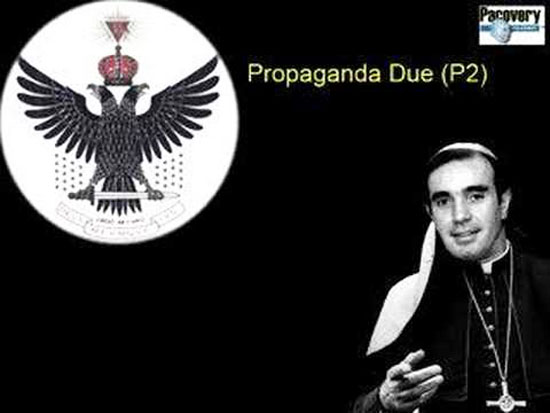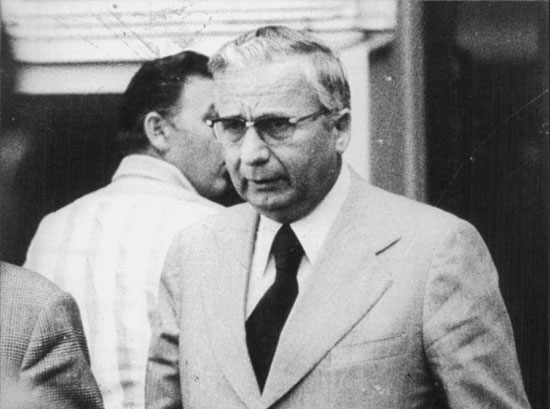Operation Gladio: The Unholy Alliance between the Vatican, the CIA, and the Mafia (2)
Read the first part of the article
The Terror
Following the thwarting of Italian democracy in 1948, the Gladio secret armies entered into a period of what one might characterize as pregnant incubation. Thus, it was during the 1950s that the various drug supply routes and financial networks were being created, as were some of the principal political organizations. Probably the most important of the latter was Propaganda Due, otherwise known as P2.

Created in 1877 as a Freemasonry lodge for the Piedmont nobility, it was banned by Mussolini in 1924 only to be resurrected post-war with the approval of Allen Dulles, himself a thirty-third degree Mason. The lodge, though at first dominated mainly by spooks, spies, military and mafia figures, would soon encompass a who’s who of Italian political, corporate, banking and media supremos to boot.
Indeed, the organization would eventually spread shoots throughout Europe as well as North and South America, and its members would come to include such so-called “luminaries” as Henry Kissinger and General Alexander Haig.
A P2 denizen of especial significance was Licio Gelli. The latter’s pedigree was impressive: a former volunteer in the 735th Black Shirts Battalion, a former member of the elite SS Division under Field Marshall Goering and, thereafter, a chummy employee of the US Counter Intelligence Corps of the Fifth Army.
Working with William Colby, the OSS agent in France, and Allen Dulles, the OSS director, Gelli soon gained entry to the Vatican where he helped set up the Nazi escape routes to Argentina. His ties with Argentina would later prove critical in facilitating Operation Condor (the US-backed mass assassination program in 1970s and ’80s South America).
Moreover, in 1972, Gelli would emerge as P2’s supreme “Worshipful Master” under whose leadership the lodge would reach its full, horrific flowering. Finally, it is worth mentioning at this juncture that it was as a result of a police raid on Gelli’s villa in 1981 that the full, tentacled structure of Gladio would come to light.
One of the first substantive actions of Gladio was the Turkish coup of 1960. Here the incumbent Prime Minister, Adnan Menderes, made the fatal mistake of believing he was really in charge and thereafter initiating a visit to Moscow to secure economic aid. The stay-behind army in Turkey known as Counter-Guerilla, in alliance with the Turkish military, quickly disabused him of any such delusions by arresting and executing him.
Throughout the 1970s, both Counter-Guerilla and its youth wing, the Grey Wolves, would stage “ongoing terror attacks… that resulted in the deaths of over five thousand students, teachers, trade union leaders, booksellers and politicians”.
Counter-Guerilla would also figure in the Turkish coup of 1980 when its commander, General Kenan Evren, toppled the moderate government of Bulent Ecevit. According to Williams, US President Jimmy Carter phoned in his approval to the CIA station-chief in Ankara, Paul Henze, with a jubilant “Your boys have done it!”. What they had done, of course, was set up a tyranny in which thousands more would be tortured while incarcerated.
The Turkish Gladio boys would also be unleashed in the 1980s upon the PKK – the Kurdistan Workers Party. All of this was in keeping with Zbigniew Brzezinski’s (Carter’s national security advisor) core vision of the importance of controlling Central Asia to which Turkey was both a vital portal and, thus, a key NATO ally.
Alas, Gladio would prove something of a “disappointment” in France, where, after having backed a series of assassination attempts against the regrettably too independent President Charles de Gaulle, it found itself on the receiving end of de Gaulle’s boot.
Actually, it was NATO itself – at the time, headquartered in Paris – that was unceremoniously kicked out of France (in 1966, whence it took up its present cozy and famously corrupt abode in Brussels). But, of course, de Gaulle was ahead of the curve and understood all too well who was really behind the mayhem and murder.
Greece, unfortunately, did not fare as well. In 1967 the Hellenic Raiding Force, a franchise of Gladio and playing to a NATO authored script entitled Operation Prometheus, overthrew the left-leaning government of George Papandreou. The ensuing military dictatorship would last until 1974 though this would hardly signal the end of Greece’s tribulations.
From 1980 until near the turn of the millennium, the nation would suffer under a reign of terror and political assassinations nominally attributed to “November 17”, an alleged Marxist revolutionary group, but which in fact was yet another faction of Greek-Gladio known as Sheepskin.
This illustrates a point originally brought home by Ganser’s research to the effect that virtually every alleged “leftist revolutionary” group said to have been operating in Europe throughout the post-war years was, in truth, either a Gladio secret army unit or else had been completely infiltrated by state intelligence services, and was subsequently being steered by them for Gladio-style state-terrorist ends.
Such is well documented for the Red Brigades in Italy and the Baader-Meinhof Gang in Germany (the gang being conveniently and cold-bloodedly exterminated on the “night of the long knives”, Oct.18, 1977, whilst under custody in Stammheim prison). It also, just by the by, speaks to the universally attested prior association of many a modern-day terrorist and their police and intelligence handlers.
In Spain, during the early ’70s, Stefano delle Chiaie and fellow Gladio agents from Italy provided their consulting expertise to General Francisco Franco’s secret police who conducted over a thousand violent acts and some fifty murders.
Following Franco’s death in 1975, delle Chiaie moved to Chile to lend a fatherly hand in helping the CIA-backed Augusto Pinochet set up his death squads. In later years the Spanish Gladio unit would find gainful employment hunting down and assassinating the leaders of the Basque separatist movement.
Of Italy we have already mentioned the “years of lead”, but let’s capture a few highlights. The “strategy of tension” unleashed in 1969 in Italy – the same year Condor was unleashed in Latin America – was in response to the renewed popularity of Communism throughout the country and which, itself, was partly in response to the uptick in revolutionary sentiment globally as a result of antipathy towards the US war on Vietnam.
The antidote, naturally, to this woeful state of progressive affairs was a healthy dose of terror. According to Williams, “Henry Kissinger, Nixon’s National Security Advisor, issued orders to Licio Gelli through his deputy, General Alexander Haig, for the implementation of terror attacks and coup attempts.” The terror attacks began on December 12, 1969 when a bomb exploded in the crowded lobby of a bank in Milan’s Piazza Fontana in which seventeen people were killed and eighty-eight injured.

Licio Gelli
Over the ensuing years (from 1969 to 1987) there followed more than 14,000 acts of violence with a political motivation. The most infamous of these was, of course, the Bologna bombing in August of 1980 and which led to the initial exposure of Gladio in Italy.
Of the many attempted coups and related high-level political machinations engineered by Gladio forces in Italy (1963, 1970, 1976) and Sicily (more or less continually on tap throughout the decade), the kidnapping on March 16, 1978 – and murder a month or so later – of Prime Minister Aldo Moro was likely the most sensational. Moro had dared to include communists in his new coalition government.
At first blamed on the usual suspects, i.e. the Red Brigades, further investigation (to begin with by journalist Carmine “Mino” Pecorelli who paid with his life) led to the real usual suspects including CIA operative Mario Moretti (eventually convicted of the killing) and thence up the line to Gelli, then to Italy’s interior minister Francesco Cossiga and onwards to Zbigniew Brzezinski.
The high-level intrigue did not stop at the murder of a prime minister however. At least two Popes felt the sharp end of the Gladio sword as well. In August of 1978, Pope Paul VI died. His successor, the preternaturally timid John Paul I, soon gave his handlers a very real shock when, after looking at the IOR accounts, he issued a “call for reform”.
The very next day, the otherwise fastidiously health-conscious pontiff – in office barely a month – was dead. Not just dead, but expired with the telltale bulging eyes and horrific grimace of acute poisoning. His autopsy was definitively thwarted by an illegal and hastily contrived embalming, and his personal papers disappeared without a trace.
Archbishop Marcinkus, having been temporarily removed prior, was returned to office whilst Calvi and Sindona, also under scrutiny at the time, breathed a (temporary) sigh of relief.
Having been (almost) burned once, the overseers of Gladio made sure to engineer the follow-up Papal succession. Thus did Cardinal Karol Wojtyla shuffle onto the historical proscenium as Pope John Paul II. Now, at first, John Paul worked seamlessly with the CIA and Gladio. Together they oversaw the destruction of Liberation Theology in Latin America, the continued undermining of Italian democracy, and the dispensing of black funds for Solidarity in Poland.
By the spring of 1981, not only were events spinning out of control for Gladio itself, but so too were they for Banco Ambrosiano, and by extension, the IOR. The Pope, inexplicably, refused to act. Compounding this lapse was an unaccountable trifecta of moral turpitude that witnessed the Holy Father suddenly breaking into treasonous “song singing” the benefits of rapprochement with the Soviets; recognition of the Palestine Liberation Organization; and, egads, nuclear disarmament.
The order from on high was given: “Kill the Pope”. But best blame it on the Soviets. So issued the “Bulgarian Thesis”, wherein a lowly Bulgarian airline employee (Sergei Antonov) was set up as the patsy. In truth, the key actors in the papal plot came straight from Gladio central casting. The starring role in the drama fell to General Giuseppe Santovito, the head of Italy’s military intelligence (SISMI) and the commander of the Italian Gladio units.
His co-star, Theodore Shackley, was the infamous CIA mastermind who had already served as executive producer on such epics as Operation Phoenix (involving the murder of some 40,000 non-combatants in Vietnam), Operation Condor, the setting up of Nugan Hand Bank, and, along with Delle Chiaie, the murder of Salvador Allende. West Germany’s BND (the national security services) garnered a significant credit by harbouring and financing the two actual assassins, Mehmet Agca and Abdullah Cath (both from Turkish Gladio).
And, of course, the Mighty Wurlitzer, i.e. Operation Mockingbird, figured prominently in the aftermath grinding out endless tunes on the “Bulgarian Thesis” – despite the fact of Agca’s eventual (lone) conviction in the shooting. The production ended all somewhat anticlimactically, when the Pope (on May 13, 1981) was only seriously wounded. In a fascinating denouement, however, on Christmas Day 1983, the Pope opted to publicly forgive Agca.
Italian state television was allowed to record the moment when John Paul asked his assassin from whom he had received his orders. Leaning forward to hear Agca’s response, the Pope appeared momentarily frozen, then clasped his hands to his face. Though the Pontiff kept it secret, there was little need to guess at the answer.
The adventures of both Agca and Cath are the stuff of legend. Indeed, Cath figures in events well beyond the time line of Gladio proper, enough to suggest that Gladio never really shut down at all.
yogaesoteric
June 14, 2019
